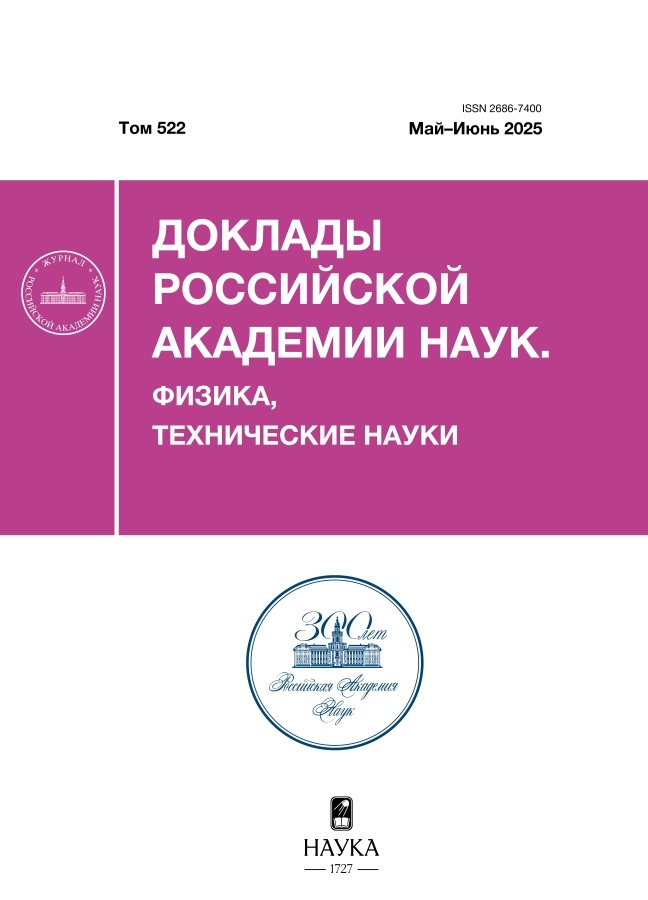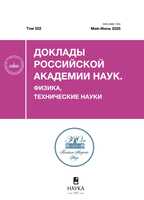Doklady Rossijskoj akademii nauk. Fizika, tehničeskie nauki
ISSN (print): 2686-7400
Media registration certificate: № FS 77 - 77142 dated 06.11.2019
Founder: Russian Academy of Sciences
Editor-in-Chief Garnov Sergey Vladimirovich
Number of issues per year: 6
Indexation: RISC, White List (level 3)
Current Issue
Vol 522, No 1 (2025)
ФИЗИКА
Development of the principle for the actual state of a physical system
Abstract
The energy principle for the actual state of a physical system with distributed parameters is formulated using the example of problems formulations in linear theories, fluid, and thermal conductivity. It is shown that if the system state variables are chosen in appropriate way, all the considered problems of mathematical physics are reduced to one universal formulation. This description of the system makes it possible not only to evaluate the quality of approximate solutions, but also to estimate the perfection of the mathematical model used.
 3-9
3-9


Depletion of nonlinearity for space-analytic space-periodic solutions to equations of the hydrodynamic type
Abstract
We consider solenoidal space-periodic space-analytic solutions to the equations of hydrodynamics. An elementary bound shows that due to the special structure of the nonlinear terms in the equations for modified solutions, effectively they lack a half of the spatial gradient. This appears to be a novel mechanism for depletion of nonlinearity. We present a two-phase iterative procedure yielding an expanded bound for the guaranteed time of the space analyticity of the hydrodynamic solutions. Each iteration involves two phases: In phase 1, the enstrophy of the modified solution and the bound for the radius of the analyticity of the original solution simultaneously increase (the bound is proportional to the elapsed time since the beginning of phase 1). In phase 2, the enstrophy and bound simultaneously decrease. It is straightforward to generalise this construction for the equations of magnetohydrodynamics.
 10-15
10-15


On the shock-wave polymorphic transition in a nonporous substance
Abstract
A thermodynamic model is presented which allows a very good description of the state of matter after shock-wave polymorphic transition of the martensitic type. Based on the processing of known experimental data for a significant number of substances, important refinements of the classical concept of two-wave polymorphism have been obtained. It is shown that on the phase (p–V) plane, the points of the final state of matter after the phase transition and the states at the front of the head shock wave at a given velocity always lie on the same Rayleigh line. It is also shown that the specific volume of matter after the phase transition is equal to its value given by the elastic component of the equation of state of the new phase at pressure corresponding to the point of intersection of the Rayleigh line and the Hugoniot for the head shock wave.
 16-22
16-22


Stability, electronic and magnetic properties of Dirac semimetall Cd₃As₂, doped by manganese and chromium
Abstract
Doping Dirac semimetals by magnetic atoms promises the development of new topological materials with broken time-reversal symmetry. According to the theoretical models, the unusual transport properties should be observed in such materials: negative magnetoresistance, π Aharonov–Bohm effect, quantum Hall effect and other ones. However, the real alloys are complex objects which differ in many ways from model representations. In this paper the stability and properties of two substitutional alloys are analysed by means of the first principles calculations: (Cd1–xMnx)3As2 and (Cd1–xCrx)3As2. The main difference between these two topological alloys is due to the type of doping: isovalent in case of Mn and non-isovalent in case of Cr. Our calculations show that the valence of doped atoms determines directly the position of the Fermi level and the nature of spin ordering in alloys under consideration, as well as the preservation of the Dirac cone in electron spectrum. The features found are of a regular nature and weakly depend on the details of the spatial arrangement of magnetic atoms in alloys.
 23-34
23-34


Equations of state of carbon-fiber composite, epoxy resin, carbon and the principle of additivity at high pressures
Abstract
The equations of state of epoxy resin, carbon-fiber composite and carbon at high pressures of the megabar range have been developed. The principle of additivity for calculating of the mixed shock adiabat of carbon-fiber composite based on the shock adiabats of epoxy resin and the high-pressure carbon phase is considered. It is concluded that the additivity principle is applicable for calculating the shock adiabats of polymer composite materials in the entire studied pressure range.
 35-38
35-38


МЕХАНИКА
Virtual gravity assists maneuvers in the interplanetary ballistic mission design
Abstract
It is shown that the backward in time extension of the spacecraft interplanetary launch trajectory from the point of the low orbit of the departure planet generates a trajectory structurally coinciding with the virtual gravity assist trajectory near the departure planet. The beam of virtual flight hyperbolas built on its basis generates (after they are pulled to their pericenters) trajectories slightly different from the design departure orbit of the spacecraft. Thus, the search for the trajectory of an interplanetary flight can be separated from the need to take into account the boundary conditions of the launch from an intermediate low prelaunch orbit. The pre-launch orbit is refined on the results of the search for the trajectory of the interplanetary flight. A structurally uniform scheme of ballistic design of spacecraft flight paths using multiple gravitational maneuvers based on the consideration of planetary ephemerides is presented.
 39-44
39-44


Criterion for the laminar-turbulent transition onset in a compressible boundary layer
Abstract
A criterion of the laminar-turbulent transition onset in a compressible boundary-layer flow is formulated on the base of Liepmann’ assumption according to which the critical condition is reached where the Reynolds stress (caused by the laminar oscillations) becomes equal to the shear stress of the base (undisturbed) flow. Comparison with known results of direct numerical simulations of disturbances propagating in the non-gradient boundary layers on flat plates and sharp cones at zero angle of attack showed that the criterion works well in a wide range of local Mach numbers (0 < Me < 7) for different mechanisms of the nonlinear breakdown of unstable waves.
 45-50
45-50


Research of annular nozzle thrust in the turbulent outflow condition
Abstract
The results of calculations and measurements of the annular nozzle thrust force in a turbulent outflow regime of high-temperature combustion products are presented. Calculations are carried out on the basis of the Favre-averaged Navier–Stokes equations and the Boussinesq approximation for describing the processes of turbulent transfer. The analysis of exhaust nozzle form of annular device with internal deflector on the value of developed thrust is performed. By results of comparison of calculated and corresponding measured values of annular nozzle thrust it is performed validation of calculated model. It is established, that in the cavity of the inner deflector a “stationary” turbulent regime with high values of the turbulent transfer parameters is established.
 51-57
51-57


Solution of longitudinal shear problems of physically nonlinear bodies with properties depending on the type of stress state
Abstract
Deformation properties of structural materials, rocks, composite materials, etc. depend on the type of external action, and the degree of this dependence is determined by the structural features of the materials. These materials are characterized by a relationship between volume and shear deformation. Deformation curves are nonlinear even at small deformations. This paper presents constitutive relations describing the nonlinear behavior of these materials under small deformations. It is shown that classical hypotheses of anti-plane shear cannot be applied. The problem of anti-plane shear of a long prismatic body with a square cross-section containing a round through hole in the plane of the cross-section is solved numerically. It is shown that under shear loading conditions, the body is characterized by a triaxial stress state and a change in volume.
 58-64
58-64


ТЕХНИЧЕСКИЕ НАУКИ
Detection of phytopathogens on cotton seeds and their disinfection using aqueous solutions treated with low-temperature piezoelectric direct discharge plasma
Abstract
The effect of low-temperature plasma initiated by a piezoelectric direct discharge on biological and water-containing objects is a promising method for disinfecting planting material and regulating growth. The article shows that plasma-activated water created by this method significantly suppresses the activity of phytopathogens Xanthomonas citri pv. Malvacearum, Verticillium dahlia and Fusarium oxysporum f.sp. vasinfectum on cotton seeds. Phytopathogens were identified using real-time PCR and microscopy. A fluorescent method for detecting these phytopathogens has been developed for the effective use of aqueous solutions treated with low-temperature plasma in field conditions.
 65-70
65-70


Numerical modelling of the initial stage of popigai crater formation
Abstract
An impact formation hypothesis for the Popigai diamond deposit is the most common these days. Theoretical research of hypervelocity impact of a massive chondrite asteroid on the Earth's surface near Popigai river region was carried out using computational gas dynamics methods. We simulate an ordinary chondrite spherical asteroid collision with a layered structure of the Earth's soil in the initial velocity range of 15–20 km/s as most possible velocity span. The natural carbon deposit layer is located in the near-surface zone of the loaded area. The calculations were carried out using a parallel three-dimensional implementation of the finite-size particle-in-cell method. Models of the equations of state of chondrite, quartz and carbon are used to describe the properties of the meteorite and soil material. Thermodynamic parameters of impact compression of soil materials at the initial stages of loading and crater formation processes are obtained.
 71-73
71-73


Structure, phase composition and properties of amorphous soft magnetic Fe–Co–Si–B–P tapes
Abstract
The analysis of structural and phase states, mechanical and magnetic properties of amorphous FeCoBSi and FeCoBSiP alloys obtained by spinning is performed. The distribution of the elemental composition is traced and the alloy stratification by silicon and boron is noted. It is shown that the experimentally determined values of saturation induction (1.7–1.8 T) and coercive force (18–20 A/m) are practically independent of changes in the composition of the tapes in the studied range of element content. The values of ultimate strength (~162 MPa) and elongation before failure (~0.23%) indicate low plasticity of the studied tapes. However, the value of the elastic modulus was high at 81.5 MPa.
 74-80
74-80













